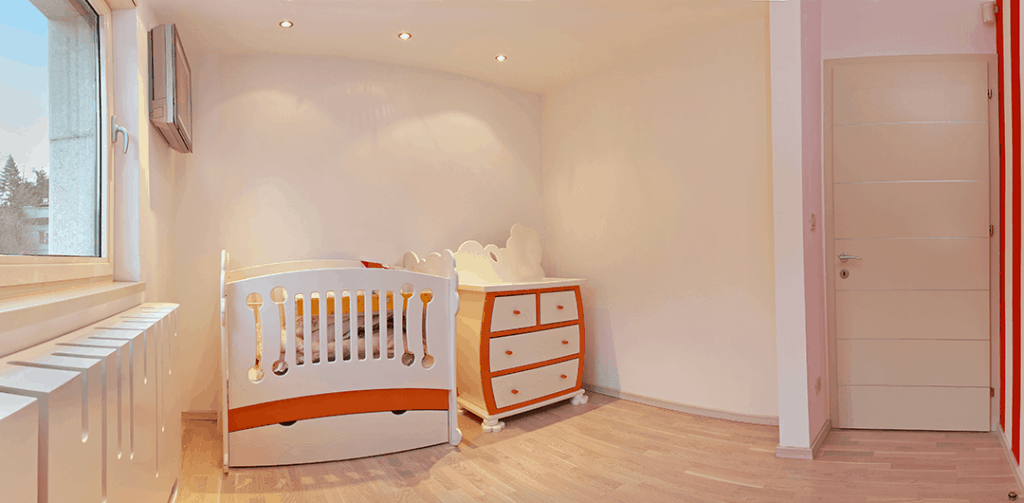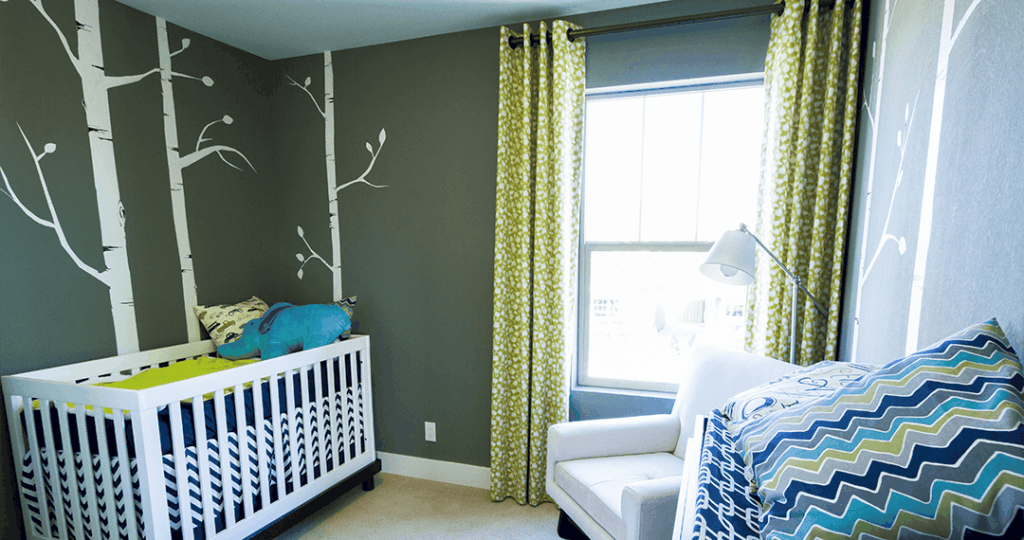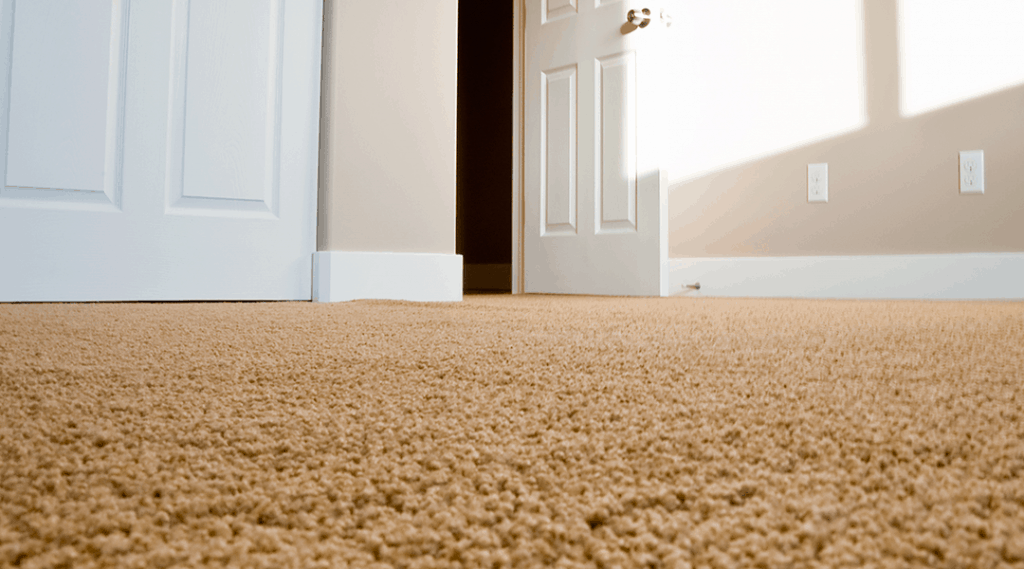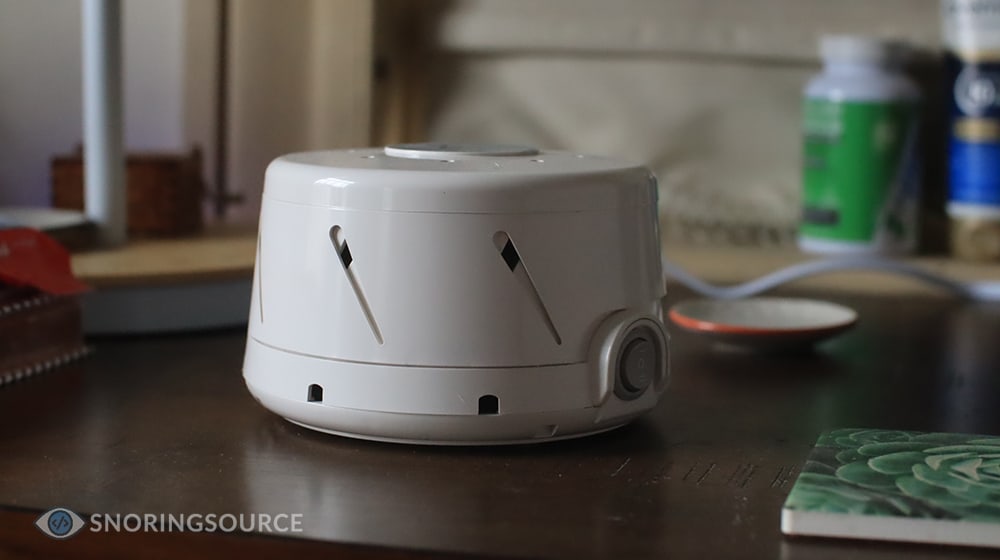The main goal when soundproofing any room is to suppress, absorb, reflect, or diffuse sounds in order to minimize airborne and impact noises. In order to accomplish this you'll need to to stop air leaks and deaden vibrations.
When it comes to a nursery, there are two main reasons for soundproofing:
Note: The suggestions in this article are similar to that of soundproofing a regular bedroom.

The best first step is to invest in a solid-core door. Most interior doors are quite hollow and are manufactured from thin materials. Unlike your front-door, these materials have air gaps which allow sound to be transmitted.
Replacing the door can be quite costly due to increased material costs. You can expect to pay $200-300 for a solid-core door. If you don't have the money, you have a few options: add density to the door and stop air leaks.
There are a few ways to add mass to a door. The easiest is with either Mass Loaded Vinyl (MLV) or acoustical sound board. These materials should be placed on the room-side of the door.
If you don't have MLV or sound board, you can hang a thick blanket or a tapestry in order to achieve a similar result.
Preventing air leaks can be a bit more complicated. In order to prevent air leaks:
Checking for air leaks is rather simple. Stand inside the nursery and shut the door. Turn the lights off and check to see if any light shines through. If you see light shining through, you have an air leak. Remember, air is a great medium for transmitting sound (airborne sound).

If your nursery doesn't have windows, you can skip this step.
Windows are one of the most important targets to soundproof in any room. Windows have a lot of the same problems as your door, except they're also exposed to the outside world and all the sounds that come with it.
The process for air sealing windows is the same as your door: an acoustical sealant and weatherstripping.
The next thing to take into consideration are the glass panes. If you have a newer home, chances are you'll have double or triple-pane windows which are great for insulation. However, older houses have single-pane that don't seal very well.
Just like your door, you could simply replace the windows. Replacing an entire window can be quite costly. Instead you might consider investing in a transparent window insert or using a window plug.
Like double-pane windows, the insert/plug acts as a barrier to create dead space; The dead space results in noise reduction.
If the above options aren't viable for you, using soundproof curtains or drapes are a great alternative. In my experience, soundproof curtains are great for deadening sound but are not great as sound blockers.
In a similar way to the doors, you can think of the curtains as mass loaded vinyl. Meaning, the more density you have between the nursery and the window, the less sound that can transmit.
Instead of using two drapes, invest in four. Just like MLV, more drapes means more density/mass of the curtains and less sound. However, temper your expectations in terms of the ability for fabric to attenuate airborne sound.
James Burkett
You could also use a large tapestry, however the material is usually thin and the sound won't be deadened as effectively or at all.

We noted above that one of the goals of soundproofing any room is to reduce impact noise. Impact noises are the result of two objects colliding. The impact creates vibrations that resonate throughout a space.
Think of a Woman walking in heels on a wooden floor. The heel striking and the floor are the two objects colliding and the sound resonates throughout the structure.
The best way to reduce impact noises is by installing wall-to-wall carpeting with dense padding (in some cases like apartment dwelling, this may not be possible). You may consider installing a carpet underlayment that's comprised of mass loaded vinyl bonded to closed cell foam.
Wall to wall carpeting can be expensive and some people prefer other flooring materials. At the very least, consider using area rugs throughout the space.

It might seem counter-intuitive to add noise when you're trying to eliminate it but a white noise machine can help to mask other sounds that naturally occur in an environment.
They can also have a calming and therapeutic affect. For instance rain on a metal roof or ocean waves crashing.
Some white noise machines are made specifically for infants. They can feature lullabies or even sounds that mimic a mother's heartbeat.
In 1990 a study that was published in the Archives of Disease in Childhood[1] found that white noise was beneficial in helping newborns sleep.
The study looked at two groups of twenty neonates, 2-7 days old. In response to the white noise, sixteen neonates of twenty, or 80%, fell asleep in five minutes. In the control group, only five of twenty, or 25%, fell asleep spontaneously.
However, white noise machines can also be problematic. In 2014, the American Academy of Pediatrics (AAP) measured the sound levels of 14 infant sleep machines[2].
All fourteen machines produced sound levels greater than 50 dBA, which is greater than the recommended noise limit for infants in hospital nurseries.
A baby's sleep cycle is very important. Babies have many periods of active "light" sleep and quiet "deep" sleep. During periods of active sleep, babies are more susceptible to waking up due to external noises.
They have two different kinds of sleep – active sleep and quiet sleep. In active sleep your baby moves around. You might see jerking, twitching or sucking. In quiet sleep your baby is still and breathing evenly.
Raisingchildren.net.au
Soundproofing surfaces like the door and windows are good first targets. They typically transmit the most noise throughout a space. Decorating the space and having wall to wall carpeting can also help a lot with sound deadening.
While white noise can work wonders for some babies, they may not for yours. Just like Adults, babies are also unique and have different sleep needs. Ensure to check the dB rating of the noise maker to ensure it's at or under 50 dB to prevent any sort of sound pollution that could harm your child.

Snoringsource.com is a participant in the Amazon Services LLC Associates Program, an affiliate advertising program designed to provide a means for website owners to earn advertising fees by advertising and linking to amazon(.com, .co.uk, .ca etc) and any other website that may be affiliated with Amazon Service LLC Associates Program.